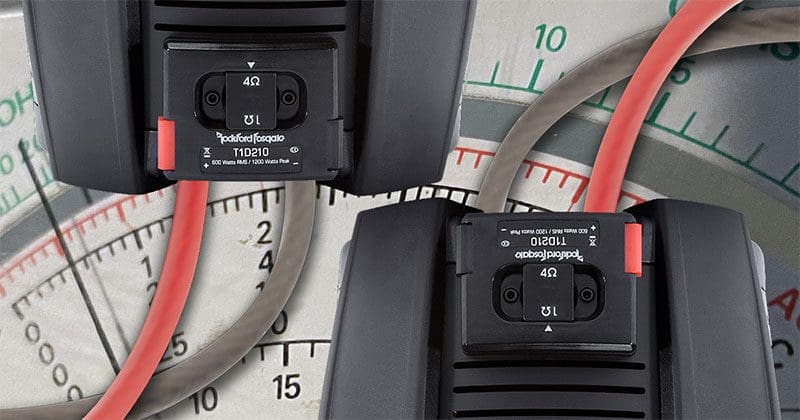It seems do-it-yourself installers have taken a liking to our discussion about wiring multiple subwoofers to a single amplifier. The popularity makes sense, since many car audio enthusiasts aren’t familiar with series and parallel wiring. A question came up on Facebook a few weeks ago asking if it was better to wire a pair of dual voice coil subwoofers in series with their coils in parallel or vice versa. We thought it might be fun to turn that question into yet another experiment and dive deep into the options of series-parallel wiring.
Wiring Dual Voice Coil Subwoofers
Unless your installer has access to some very low impedance subwoofers, most installations will see the subwoofers you have purchased wired in parallel. For example, say you’ve chosen a pair of 10-inch subs with dual 4-ohm coils. In that case, your installer could wire all four coils in parallel to present a 1-ohm load to a monoblock subwoofer amplifier. What if you’re after a solution that will offer the best sound quality possible, and you’ve chosen a two-channel Class-AB amp to power your subwoofers? In most cases, these amplifiers want to see a 4-ohm load when bridged. It’s not difficult to wire a pair of dual 4-ohm subwoofers to present this load, but there are a couple of options.
Series the Coils’ Woofers on Each Driver, Parallel the Subwoofers
Your installer’s first option is to wire the voice coils on each subwoofer in series. For our dual 4-ohm subwoofers, this wiring configuration would add the voice coil impedance on each driver to produce a nominal 8-ohm load. Next, your installer would wire each subwoofer in parallel with your amplifier to create a 4-ohm load.

Parallel Each Woofer’s Coils, Series the Subwoofers
The second option is to wire the voice coils on each subwoofer in parallel, then wire the two subwoofers in series with each other to the amp. Each subwoofer would have a net impedance of 2 ohms, and wiring those loads in series would present our amplifier with a 4-ohm load.

However, our subwoofers aren’t resistors. We talked about the reactive characteristics of speakers and subwoofers not long ago in this article. Since we’re dealing with inductance and capacitance along with the resistance of the voice coil, is there a chance that the two wiring options present different results in terms of performance? Let’s see what happens!
Let’s Do a Test!
We have a pair of 10-inch subwoofers that we’ve meant to install into the sound system in our office. Yes, we need the ability to reproduce 25 Hz with authority while watching Cleetus McFarland, AvE, Project Farm and bigclivedotcom on YouTube. OK, maybe we don’t NEED it, but we want it. As we described in our examples above, the subwoofers have dual 4-ohm voice coils, so they’ll be perfect candidates for our experiment.
First, we measured the Thiele/Small parameters of one subwoofer using our new Clio Pocket 1 portable measuring system. Next, we measured the sub with its voice coils wired in series and then again with the coils wired in parallel to generate the data below.
Not surprisingly, the mechanical characteristics like resonance frequency (Fs) and compliance (Vas) didn’t change. As we expected, the electrical measurements like DC resistance, electrical Q, and inductance (at 1 kHz) did change.
Electromechanical Series-Parallel Wiring Results
Next, we wired the subwoofers together in the configurations we showed in the two diagrams at the beginning of the article and repeated the measurements to see what, if anything, had changed.
We’ll start by saying that the differences are minimal. The reality is, the system will work just fine wired either way. With that said, there are signs that wiring the coils on each sub in series and wiring the subwoofers in parallel is slightly beneficial.

If you look at the chart above, the DC resistance of the C-S W-P configuration is a little lower, as is the driver’s total Q (Qts). A lower Q-factor can mean less resonance at Fs and a more accurate bass response.
Sometimes an experiment yields earth-shattering results. Other times, the outcome is subtler or less controversial. Most professional installers wire coils in series and those subwoofers in parallel. If you need a hand choosing suitable subwoofers for your car audio system or help in wiring them, drop by your local specialty mobile enhancement retailer today.


